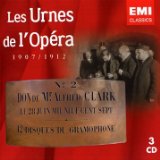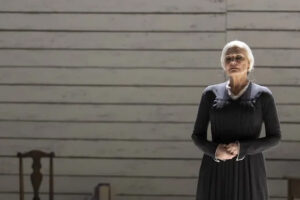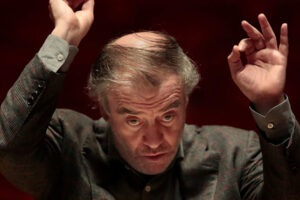
Since I had already gotten my Hanukah gift this year (my Nikon D3000 DSLR), I was surprised to receive a box from my sister this past week. One of the gifts inside was Les Urnes de l’Opera
, a collection of arias and scenes recorded shortly after the turn of the last century and buried in urns beneath the Paris Opera. The collection is 62 tracks by various artists, not limited to singers, but also including such distinguished musicians such as Fritz Kreisler and Ignaz Paderewski. I wish there were space to review all of the tracks, but rather, I’m going to single out some highlights.
American soprano Berthe Auguez de Mantalant, a singer completely new to me, sings two arias from César Franck’s La Procession, a piece I’d never heard of. Her voice is lovely, evenly produced, but the music itself doesn’t cry out for revival. She makes a stronger impression on the last disk, with “D’amour l’ardente flamme” from Berlioz’ Damnation of Faust. She sings with great beauty of tone and expressions genuine pathos.
Belgian baritone Jean Noté sings a very stylish “Pour tant d’amour” from La Favorite, and makes a strong case for the opera in French. The voice is lovely. French baritone Hector Dufranne sings “Arretons-nous ici… Vallons de l’Helvétie” from Adolphe Adam’s Le Chalet (an aria I have sung). He tosses off the coloratura with great ease.
Raoul Pugno, a French composer (1852-1914), plays his own “Sérénade à la lune.” It is played beautifully and is quite atmospheric.
Selma Kurz sings the lovely song by Eva Dell’Acqua (1856-1930), “J’ai vu passer l’hirondelle”. It is a showpiece that should be revived by an enterprising lyric-coloratura. Ms. Kurz has a gorgeous voice, and uses it with great taste. (Remember the taste issue. It will be mentioned again later).
Track 22 is Francesco Tamagno singing “Niun mi tema” from Otello, a role he sang in the world premiere. It is quite thrilling. The only fault I can find with this track is that it was recorded with piano rather than orchestra. Compared with later interpreters, such as James McCracken, he is rather restrained, especially at “Desdemona, Desdemona, morta, morta” but more effective, I think. This track is followed immediately by “Solenne in quest’ora” sung by Caruso and Antonio Scotti, a beautifully matched pair of singers, caught in their prime.
Mattia Battistini sings “Da quell di che t’ho veduta” from Ernani. No mention is made, however, of who the soprano is, which is a shame, because she gives a terrific, rip-roaring performance. Perhaps because the recording is for his benefit more than hers, he’s placed a little closer to the mic, but they are terrific together. Next up are Fernando de Lucia and Giuseppina Huguet singing a duet, in Italian, from Les Pêcheurs de Perles. De Lucia has an incredible head voice with some of the loveliest floated high notes. This duet is really stunning.
Adelina Patti recorded “Batti, batti, o bel Masetto” at age 62. Besides the fact that she barely has the top notes for what isn’t a very high aria, it is so far stylistically with what we’re used to hearing in Mozart. It was a shock to listen to. The biggest disappointments, though, come from Nellie Melba. She sings “Caro nome” with almost no vibrato (I suppose it could be the primitive recording, but since the problem is only apparent in her track, I’m assuming it was her singing). She also sings an execrable “Voi che sapete”. The tempo seems to change with every measure and is too slow throughout.
Other highlights in the set include Ernestine Schumann-Heink (a German “Mon coeur”), a truly lovely “Madre pietosa, vergine” from Forza, sung by Celestina Boninsegna and Emma Calvé singing Carmen.
Caruso demonstrates why he’s such a legend in “Celeste Aida” – gorgeous line, expressiveness, and ringing tone. Paul Franz makes a strong case to me for Wagner for singing Lohengrin in French. His voice is nothing short of perfect in the music.
My favorite singing of the set, though, is French tenor Leon Campagnola singing “Ah! Leve-toi, soleil” from Roméo et Juliette and “Salut, demeure chaste et pure” from Faust. His voice is perfectly suited to both pieces. Lovely lyrical singing, with a strong top. And he holds the last note of the Romeo forever. Also tops is Léon Beyle singing a gorgeous “Aubade” from Eduoard Lalo’s Le Roi d’Ys. I’d like to hear more of the opera.
Earlier I mentioned taste, and here’s why. I have always had a fetish for coloratura sopranos, perhaps because my first taste of opera was Roberta Peters. I grew up seeing Sutherland and Sills on TV, and as we all know, I am hooked on Anna Moffo. The worst singing in the set, and least judging by taste level, is by Maria Galvany, singing a little known Arditi trifle called “L’Incantatrice”. Galvany was famous both for her acuti, on full display here, and the speed with which she sang fioratura, But just because she could doesn’t mean she should have. It’s rather vulgar.
All in all, though, this is an excellent collection for anyone interested in the history of opera in general and singing specifically. It is from EMI Classics.
























Comments